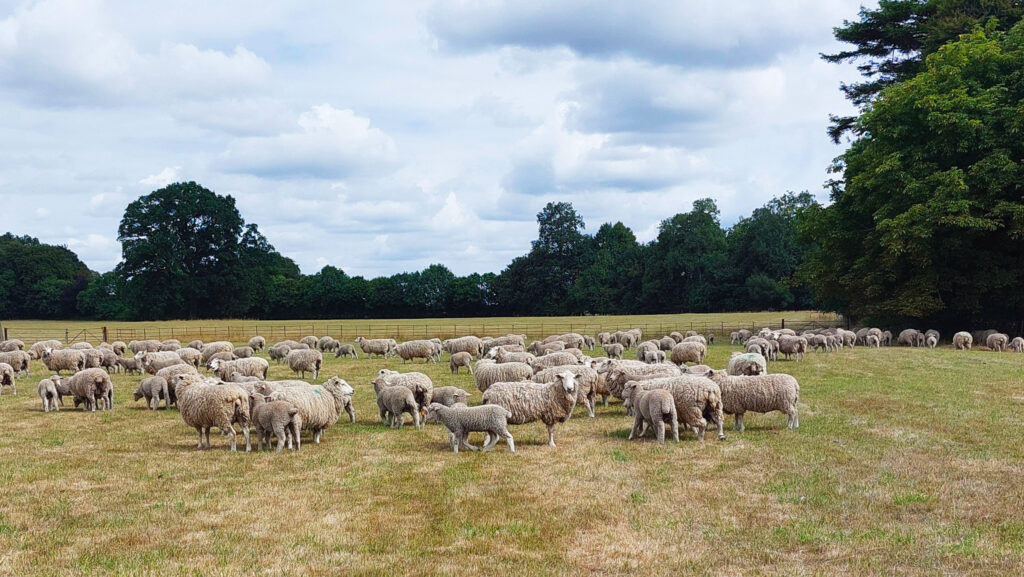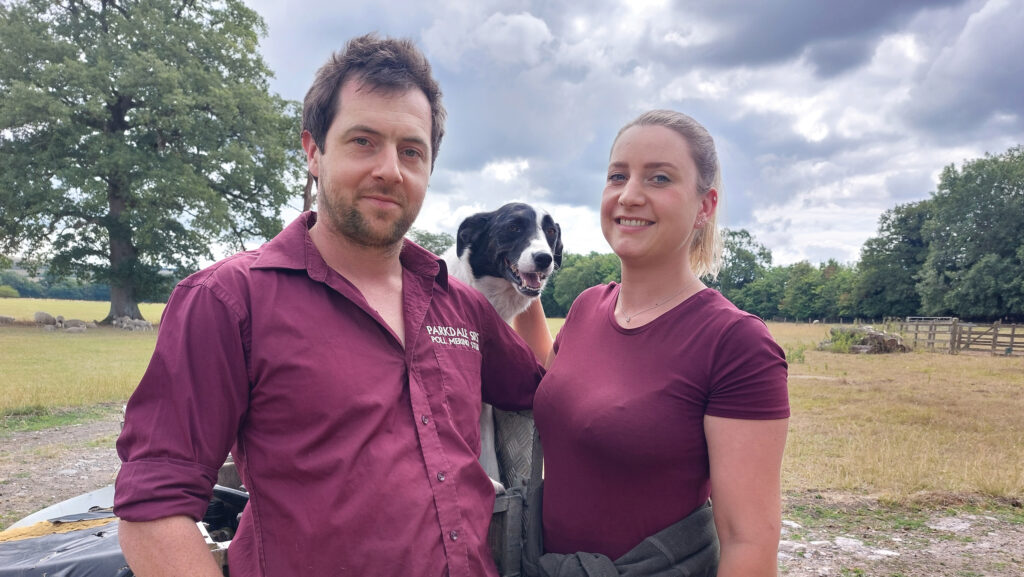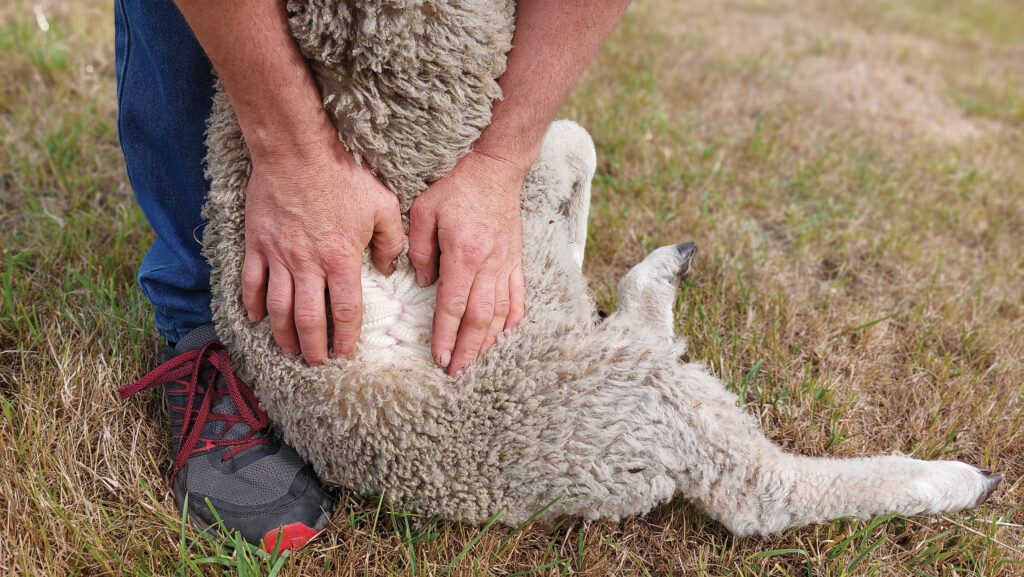How a fine-wool flock is selecting for blowfly tolerance
 © MAG/Shirley Macmillan
© MAG/Shirley Macmillan A sheep bred for high-quality wool naturally has thin skin. The bonus is that this sheep is also naturally resistant to blowfly strike.
The connection between skin thickness and strike tolerance was confirmed by Australian research into Merino genetics more than 20 years ago.
It has now become a potential solution for UK sheep farms to tackle strike through breeding.
See also: Project successfully reduces lameness in Welsh sheep flocks
A Wiltshire flock is supplying blowfly-tolerant ram lambs, together with a ewe classification service (one month pre-tupping) for selecting suitable animals to breed replacements with resistance.
Trading as Parkdale UK, Martin Howlett and fiancée Jana Grossmann, of Folly Farm, near Warminster, are selling breeding ram lambs for £1,000 a head.
Farm facts
Folly Farm, Warminster, Wiltshire

Martin Howlett and Jana Grossman with their dog Jay © MAG/Shirley Macmillan
- 105ha farmed under farm business tenancy and on licence; permanent pasture plus 8ha of herbal leys, with 40ha planned for drought-tolerant crops
- Cell grazing
- 320 New Zealand Romney ewes plus 109 replacements
- 100 New Zealand Romney and 70 Merino-Romney replacements bred this year
- Lambing outdoors in March and April
Each comes with a full breeding and health check, plus a breeding ewe assessment by Martin, and further support via telephone.
When they have built up numbers, the couple plan to also supply replacement ewes.
“We are selling 86 Merino hybrid ram lambs this year, with me as consultant.
“I will classify ewes for suitable skin to be put to our rams, so the progeny will be tolerant, without sacrificing maternal or carcass traits,” Martin says.
Blowfly management strategy
However, breeding for natural resistance does not mean that blowfly management is no longer needed, he stresses.
It just becomes another part of it, selecting a line of ewes to breed replacements, while ensuring the rest of the flock gets fly treatment.
“If we see maggots at the tail, we shear; we still crutch before lambing, and at tailing time we treat around the tail area to protect lambs.
“We also have low levels of lameness, which reduces fly strike because the fly is attracted to foot rot,” he says.
The couple have been breeding for fine wool, as well as resistance to fly strike, for the past three years in their 320 New Zealand Romney ewes.
Their priority is a robust flock: hands-off management, low input and low cost.
“We need the sheep enterprise to be easy to run and try to run it as naturally as we can.
“We are conscious of time because we are shearing and fencing contractors as well – so although we have an emotional attachment to our flock, it’s a business,” says Jana.
Flock annual running cost comes to £10 a head, including shearing and scanning, excluding rent and finance, says Martin.
Benchmarking with their vet, they are in the top 2% of businesses. “We do not use a lot of products and have less than 2% lame,” he adds.
Strike-resistant genetics
Any flock could benefit from introducing resistant genetics, but progress will be fastest in ewes with suitable skin types.
This all depends on their breed, says Martin, who learned how to classify sheep in Australia based on a visual skin and fleece assessment (see How to assess ewes, below).
The correct skin type indicates a likely natural resilience to fly strike. He says it would be difficult to do this, for instance, in a hill breed.
“So, we recommend seeking advice on selecting for it in your own flock,” he says, although Jana points out that any long wool breed (such as Cotswold or Lincoln Longwool) should have the correct wool and skin characteristics.
Martin classified their flock three years ago. Ewes were given no routine fly prevention, but checked daily for signs of strike; those that succumbed were shorn, treated, then culled after weaning.
“Anything left, by default, was partially tolerant and bred to tups bought from Matt Smith of Resilient Romneys in Cornwall.
“We could see a measurable difference in the first generation,” he says.
In that first year, they culled 15% of ewes on skin type, which meant 85% were tolerant to strike; in the second year, this dropped to 5% culled, and this year it is 3% to 5%.
Having sourced their Romney foundation stock from Matt, and then seen the potential to market blowfly-resistant livestock, last year Martin and Jana chose Australian Merino semen.
They opted for ram 1261, a tup selected via 20 genetic markers (out of a total of 60), to inseminate synchronised Romney-Merino hybrid ewes.
The resulting three-quarter-bred Merino will become full bred in the next generation.
This, they think, gives them the best combination of maternal traits and easy lambing, with good carcass and wool characteristics.
This is in addition to blowfly tolerance, and no dip in contour along the back, which, he says, helps prevent flies laying eggs.
Welfare and performance
The Sustainable Control of Parasites in Sheep group reports that 80% of UK flocks are now affected by blowfly strike each year, and climate change is stretching the season from March to December.
It believes resistance to parasiticides is becoming one of the sheep industry’s biggest challenges to health and profitability. And Jana would agree.
She says that what happens in Australia tends to follow in Britain: after drench resistance, it is predicted that in 10 years flies will become resistant to dicyclanil, the active ingredient in some fly control products.
She points out that hardy animals with a healthy immune system and thin skin can naturally resist both fly strike and worm burden.
“So the more you can select stock that are tolerant, the better for welfare and performance,” she says.
The numbers
- 16 Average seven-week weight across triplets, twins and singles (kg)
- 30 Top-growing singles weight at 11-week weaning (kg)
- 3 Number of assisted ewes at lambing out of 320
- 90% Ewes lambing in the first three weeks
- 3 New Zealand Romney sweeper tups
How to assess ewes for fly strike-resistant skin

© MAG/Shirley Macmillan
Classifying ewes for fly strike resistance involves looking for animals that have thin skin, with small sweat glands and small grease glands.
This combination is less attractive to blowflies.
Grease shows as yellow in the fleece, and this retains moisture (sweat or rain).
The bigger the grease gland, the more it locks in sweat and creates an attractive odour to flies, says Martin Howlett.
“What you want is a long staple wool, so it has good fibre alignment. This creates good airflow to the skin, which dries it,” he says.
Thin skin helps maintain a good blood supply (and therefore nutrients) to the staple. This produces a dense staple.
The more fibres in a sq mm of skin, the more dense the fleece, which deters parasites, says Martin.
New Zealand Romneys have 30 fibres/sq mm, and Merinos 85 fibres/sq mm; he thinks that crossbreds will be halfway between the two.
To assess ewes for breeding to fly strike resistant tups, Martin examines them just behind the hip.
There is thicker skin over the rump and, on suitable ewes, when he parts the wool, he can roll the skin between his fingers.
The fibre feels soft, there is good staple length (this depends on when they were last shorn), and very little colour in the fleece.
